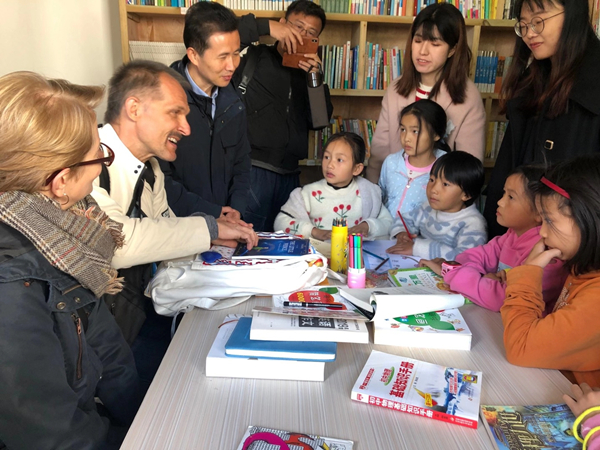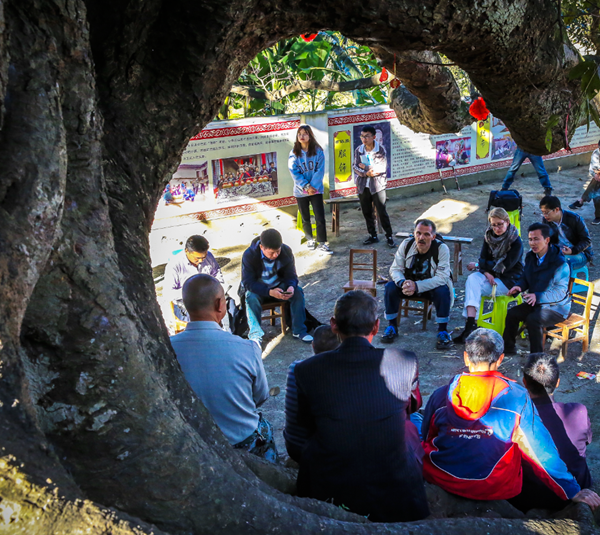Helping locals solve their problems has biggest potential for success
When talking to one of our Chinese friends several years ago, we learned that Guizhou is the most beautiful Chinese province, at least according to him. He told us that he visited Guizhou during his summer holidays every year. So in mid-November, we visited Dingwang village in Qinglong county of Guizhou, which is the "sister village" of Gejia village in Ningbo, Zhejiang province.
We participated in a local arts festival to observe the results of a development-through-art project in this village. Even though Dingwang joined the project only three months ago, positive changes are clearly visible.
The village, which is beautifully located on the slope of a mountain, is inhabited by around 200 families. Most of them belong to the Bouyei ethnic group.
Like some other places in Guizhou, Dingwang is poor and underdeveloped. At the same time, people living there are extremely hospitable, friendly and open.
In April 2020, leaders of Dingwang village came to Gejia and saw the changes achieved by the development-through-art project. It impressed them a lot. As a result, Dingwang decided to invite professor Cong Zhiqiang. Since then, the village has gone through an enormous improvement.
One of the local village dwellers said: "Before, our Dingwang village was dirty and difficult to walk through because we had no road. We used to live with animals under one roof. The animals were present everywhere. Now the village is clean. We have a new road, which makes it much easier to get in and out."
One of the first innovations in Dingwang was the creation of public spaces where people could gather, talk and play. Just like in Gejia village, it appeared to be a good idea. Thanks to this, people started to discuss the changes and realized that the village as a whole belongs to them and should be cared for by them.
This made them aware that they may exert an influence on the place they inhabit; whether it is clean or dirty, beautiful or ugly depends on them.
This responsibility is an inspiration to their lives. Art seems to be a natural ally in the effort to make a place one lives in more pleasant, supportive and integrative.
In the case of Dingwang, art was able to release the potential of entrepreneurship. Communities like this often suffer from a lack of opportunities to earn money.
The ability of a community to adapt to new circumstances, we believe, is one of the most useful criteria to find out how vibrant a given culture is.
During a conversation with one of the female villagers who was inspired by Gejia teachers and professor Cong, we learned that she and her family started decorating clothes made by them. The traditional clothing with modern decoration was interesting enough to be sold in many big cities, including Shanghai and Beijing. They are also selling clothes online and are going to open an online shop soon.
Other families with unique workshops, however, still are looking for the best way to grab the attention of potential clients. As an example, we may mention a family in which the women specialize in embroidery and the manufacturing of traditional clothing.
We have been told that the production of one outfit set, which takes around half a year to make, generates income of 2,000 yuan ($300). In another family, a woman who makes traditional shoes explained that one pair of shoes, which are made over two days, sells for 30-40 yuan.
At the same time, we need to remember that monetizing skills and the work of local people is not the first goal of the development-through-art project. The most important aim is to improve people's lives by enhancing their cultural awareness, and focusing their thoughts on the possibilities to make their surroundings better. When one is surrounded by beautiful and organized spaces, his or her life becomes fuller.
So far, we had the opportunity to observe two villages which started their adventure with development-through-art projects -Gejia and Dingwang.
Let us refresh our memory about the main goals of this project. The first one is to make rural surroundings beautiful and more pleasant to live in, the second is creating conditions that enable local villagers to monetize their potential, or earn money.
In the rural area of Qinglong county, Guizhou, the average annual income per person is-according to Feng Zhuohua, the deputy director of Qinglong county -around 4,000 yuan.
No matter who you are, if you feel that your situation needs improvement, you should be clear about the direction and methods that make those changes possible. No matter how rich or poor you are, you need a proper education to make grounded choices.
In both villages, the initial effort has been taken. We cannot be sure about the results because, in both cases, people do not get ready-made solutions with a prescription for success. Ready-made solutions often don't engage people.
During our conversations with professor Cong, we heard that there are many architects and designers in China trying to change the image of rural areas through art. But they often do it without an understanding of the local background, conditions, or people.
As a result, people are not properly educated and because of that they cannot understand and fully support the changes taking place around them. In this project, people are educated and encouraged to recognize their needs, aspirations and potential. They are encouraged to find a solution by themselves.
Projects like this, based on education and mutual trust, are by definition much more time-consuming. People cannot be educated in a day and you cannot build trust in just a week. But the results have a much better chance to last and leave deeper, positive impressions on their participants.


From top: Magdalena Gimbut and Artur Piotr Rega tell fairy tales to children in Dingwang village in Qinglong county of Guizhou. Gimbut and Rega chat with locals in Dingwang village. CHINA DAILY

 Print
Print Mail
Mail
 20 Cultural Symbols
20 Cultural Symbols Why Zhejiang
Why Zhejiang Experiencing high-tech products at WIC
Experiencing high-tech products at WIC Zhejiang Release
Zhejiang Release Zhejiang News
Zhejiang News